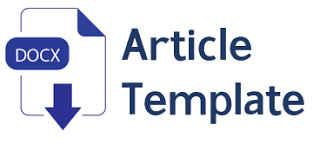TEACHING ENGLISH IN SECONDARY SCHOOL: APPROACHES, METHODS, AND TECHNIQUES
Abstract
Teaching English in secondary schools is important to give primary knowledge of English to students. Teachers need to know what the students are needed in learning English so that teachers can apply appropriate techniques in teaching. Yet, since this is the era of industrial revolution 4.0, many teachers are still blurred with beliefs and principles of language teaching so that teachers’ intervention in providing the fruitful materials and the novel techniques are usually scarcely to be found in their instruction. This study is aimed to describe the approaches, methods, and techniques applied by teachers of secondary schools in Tanjung, Tabalong when teaching English in class. This study employed qualitative case study methodology which produces descriptive data. There were 30 teachers as the participants in this research. The data were collected by using interview and a questionnaire. The result of the research shows that even some of the teachers are using materials outside of the textbook, methods and techniques of teaching English in secondary schools still do not based on demanded approaches so that the face of English teaching has the struggling to find its look in pursuing the goal of communicative competence.
Full Text:
PDFReferences
Brown, H. D. (2001). Teaching by Principles: An Interactive Aproach to Language Pedadogy. San Fransisco: State University.
Brown, H. D. (2007). Principles of Language Learning and Teaching. USA: Longman.
Bullough, R. V., Jr., & Baughman, K. (1997). “First-year teacher†eight years later. New York: Teachers College Press.
Fauziati, Endang. (2014). Method of Teaching English As A Foreign Language (TEFL). Tradititonal, Designer, Communicative, and Scientific Approach. Surakarta: Era Pustaka Utama.
Freedman, S. W., & Appleman, D. (2009). “In it for the long haulâ€: How teacher education can contribute to teacher retention in high-poverty urban schools. Journal of Teacher Education, 60, 323-337.
Holmes Group. (2015). Tomorrow's schools of education. East Lansing. M I: Author. Reproduced with permission of the copyright owner. Further reproduction prohibited without permission.
Imig. D.G.. & Switzer. T.J (2011). Changing teacher education programs: Restructuring collegiate-based teacher education. In Sikula. J. (Ed.). Handbook of Research on Teacher Education. New York: Macmillian.
Ingersoll, R., & Strong, M. (2011). The impact of induction and mentoring for beginning teachers: A critical review of the research. Review of Educational Research, 81(2), 201-233.
Katz. L.. & Raths. J. (1982). The best of intentions for the education of teachers. Action in Teacher Education. 4(1). 8-16.
Kemmis, S., & McTaggart, R. (Eds.) (1988). The action research planner (3rd). Victoria, Australia: Deakin University Press.
Kersaint, G., Lewis, J., Potter, R., & Meisels, G. (2007). Why teachers leave: Factors that influence retention and resignation. Teaching and Teacher Education Journal, 23, 775-794.
Killian. J.E. (2017). Preparing English teachers: The cooperating teachers' view. English Education. 15. 136-42.
Kirby. D.. & Liner. D. (2018). Inside out: Developmental strategies for teaching writing. Portsmouth. NH: Heinemann.
Koehler, V. (1985). Research on preservice teacher education. Journal of Teacher Education, 36, 23-30.
Lamme. L.L.. & Ross. D.D. (2013). Graduate methods classes: Do they influence teaching methods? Journal of Teacher Education. 32(6). 25-29.
Lee, R. E., Eckrich, L. L. T., Lackey, C., & Showalter, B. D. (2010). Pre-service teacher pathways to urban teaching: A partnership model for nurturing community-based urban teacher preparation. Teacher Education Quarterly, 37(3), 101-122.
Levin, B. B. (2003). Case studies of teacher development: An in-depth look at how thinking about pedagogy develops over time. Mahway, NJ: Lawrence Erlbaum Associates.
Lewis, M. & Hill, J. (2010). Practical Techniques for Language Teaching. Hove: Language Teaching Publications.
Mu’in, Fatchul, et.al. (2018). Investigating Teacher Professional Development: English Teachers’ Learning Activities as Learners. Asian EFL Journal Research Articles, 20(12), 333-369.
Ryan, K. (1986). The induction of new teachers. Bloomington, IN: Phi Delta Kappa Educational Foundation.
Skipper. C.E.. & Quantz. C.E. (1987). Changes in educational attitudes of education and arts and science students during four years of college. Journal of Teacher Education, 38(3), 39-44.
Shulman, L. (1987). Knowledge and teaching: Foundations of the new reform. Harvard Educational Review, 57, 1-22.
Ur, Penny. (1996). A Course in Language Teaching: Practice and Theory. Cambridge: Cambridge University Press.
Zemelman, S., Daniels, H. & Hyde, A. (2005). Today's Standards for Teaching and Learning in America's Schools. (3rd edition.). Portsmouth, NH: Heinemann.
DOI: https://doi.org/10.35314/inovish.v6i1.1909
Refbacks
- There are currently no refbacks.




